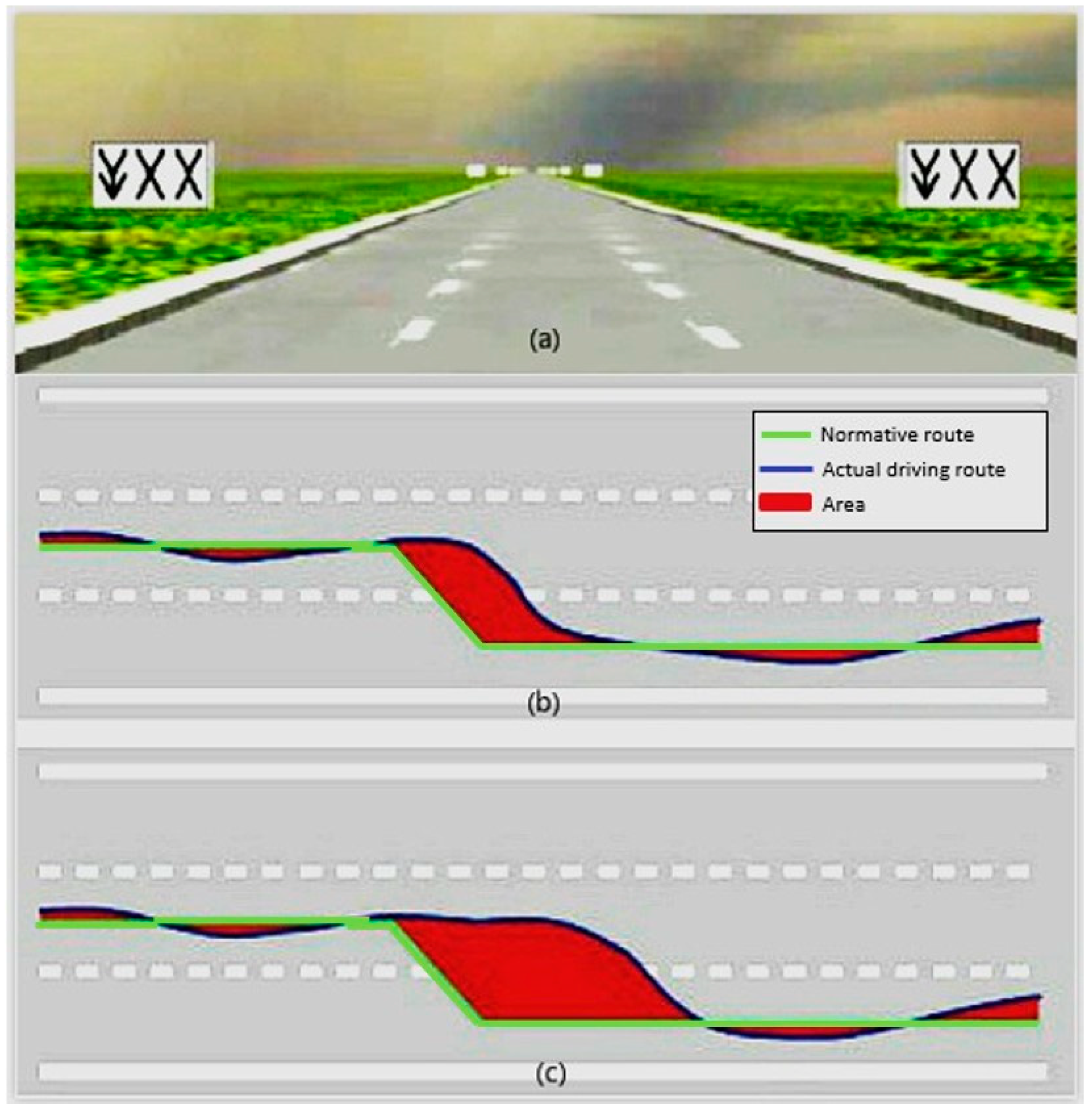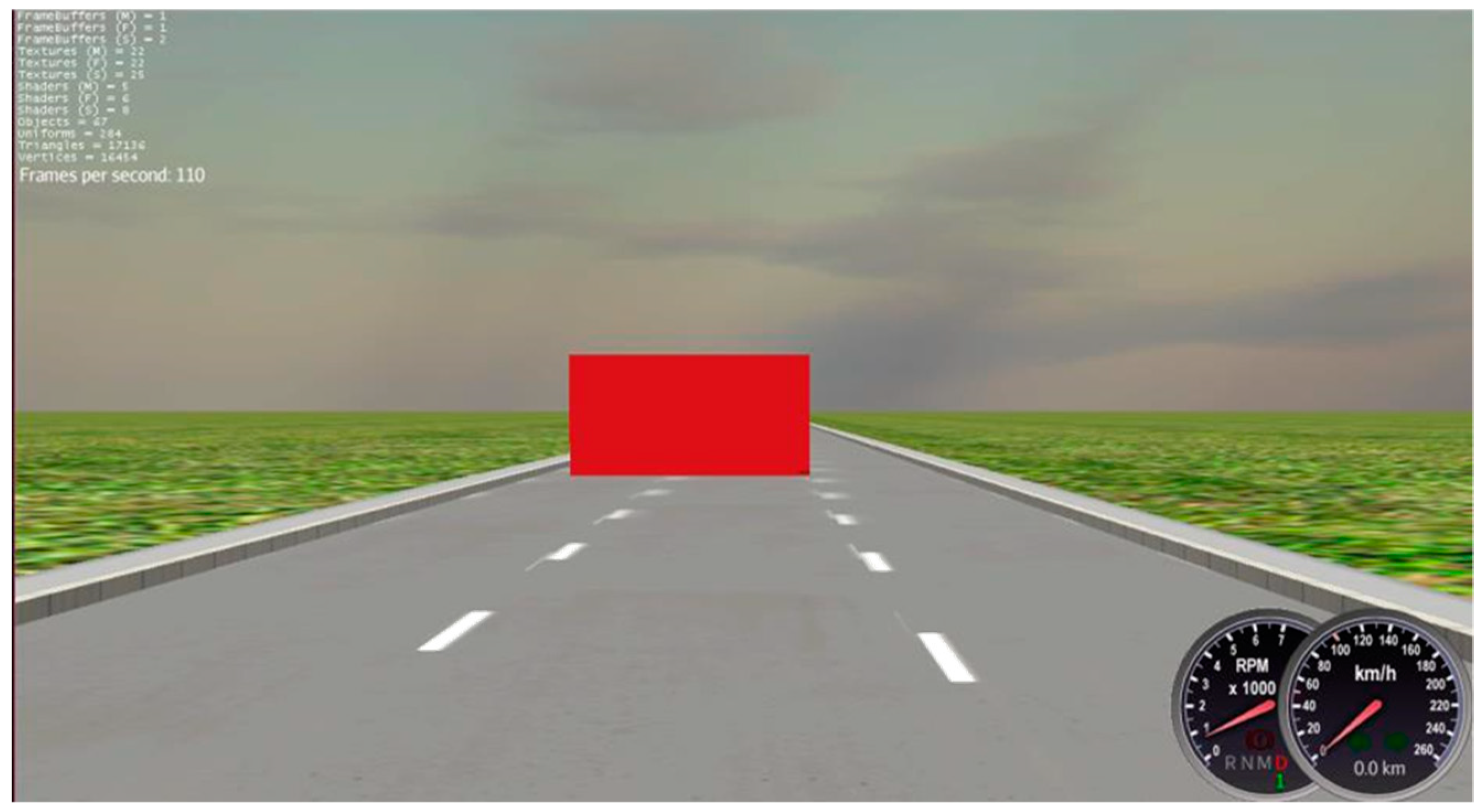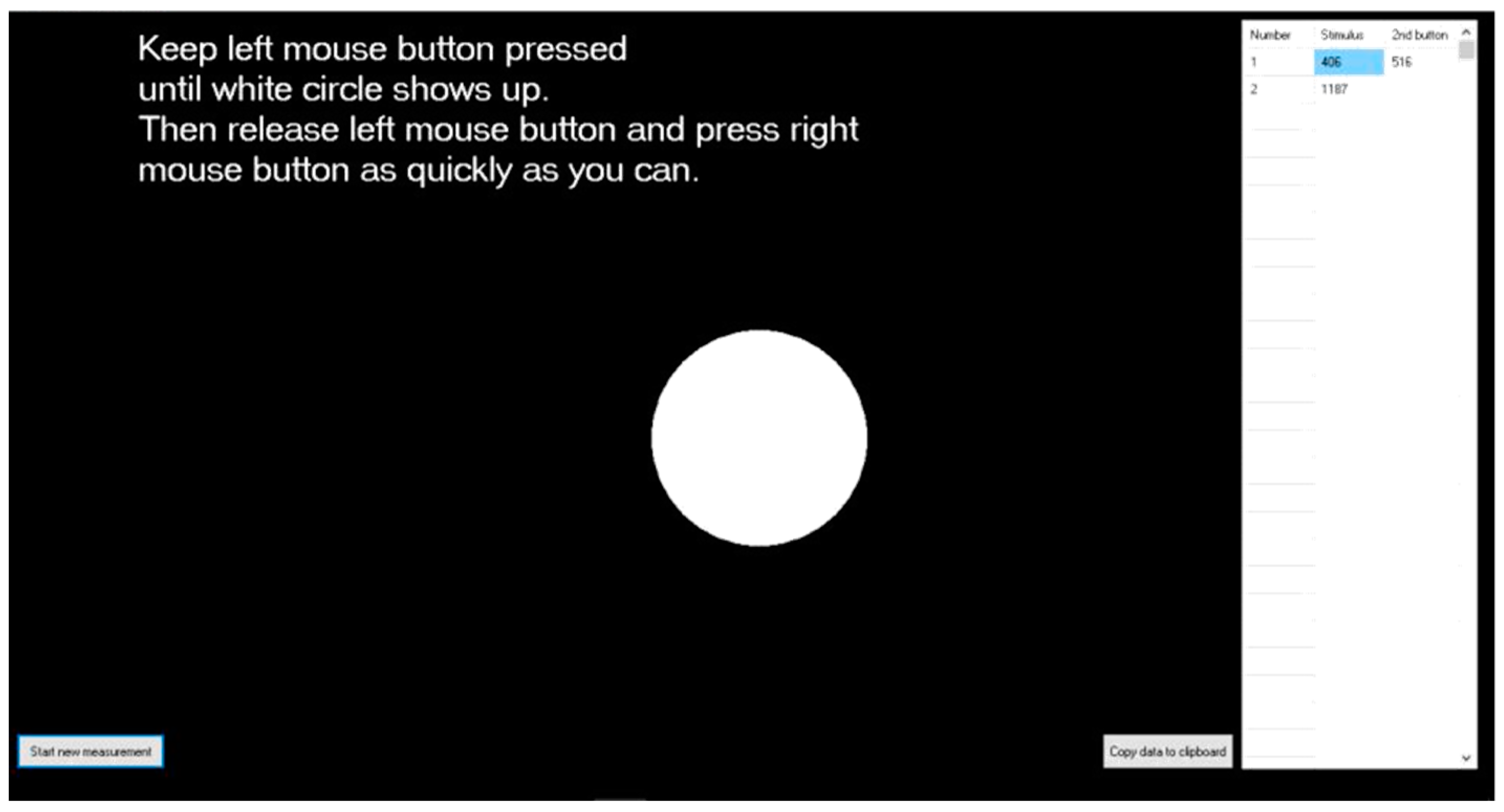Effect of Static Magnetic Field of Electric Vehicles on Driving Performance and on Neuro-Psychological Cognitive Functions
Abstract
:1. Introduction
2. Experimental Set-Up
2.1. Subject Selection
2.2. Static Magnetic Field (SMF) Exposure
2.3. Evaluating Methods
2.3.1. Lane Change Task (LCT) Test
2.3.2. Driving Reaction Time (DRT) Test
2.3.3. Reaction Time (RT) Test
2.4. Experimental Procedure
2.5. Data Analysis
3. Results
3.1. Analysis of Driving Performance and Cognitive Function Results
3.2. Impact of SMF on Electroencephalographs (EEGs)
3.3. Effect of Interaction of SMF on EEGs with Driving Performance and Cognitive Functions
4. Discussion
4.1. Discussion of the Relationship between the Beta Sub-Band and RT
4.2. Discussion on the Results of the DRT and the LCT
4.3. Discussion of the Electromagnetic Field (EMF)
5. Conclusions
Author Contributions
Funding
Conflicts of Interest
References
- Tell, R.A.; Sias, G.; Smith, J.; Sahl, J.; Kavet, R. ELF magnetic fields in electric and gasoline-powered vehicles. Bioelectromagnetics 2013, 34, 156–161. [Google Scholar] [CrossRef] [PubMed]
- Tell, R.; Kavet, R. Electric and magnetic fields <100 kHz in electric and gasoline-powered vehicles. Radiat. Prot. Dosimetry 2016, 172, 541–546. [Google Scholar] [PubMed]
- Ruddle, A.R.; Low, L. Exposures representative of traction current magnetic fields in hybrid and electric vehicles—I: Simulation of basic restrictions in a seated human. In Proceedings of the 2014 International Symposium on Electromagnetic Compatibility, Gothenburg, Sweden, 1–4 September 2014; pp. 348–353. [Google Scholar]
- Ruddle, A.R.; Low, L. Exposures representative of traction current magnetic fields in hybrid and electric vehicles—II: Safety factors provided by field reference levels. In Proceedings of the 2014 International Symposium on Electromagnetic Compatibility, Gothenburg, Sweden, 1–4 September 2014; pp. 354–359. [Google Scholar]
- Hareuveny, R.; Sudan, M.; Halgamuge, M.N.; Yaffe, Y.; Tzabari, Y.; Namir, D.; Kheifets, L. Characterization of extremely low frequency magnetic fields from diesel, gasoline and hybrid cars under controlled conditions. Int. J. Environ. Res. Public Health 2015, 12, 1651–1666. [Google Scholar] [CrossRef] [PubMed]
- Vassilev, A.; Ferber, A.; Wehrmann, C.; Pinaud, O.; Schilling, M.; Ruddle, A.R. Magnetic field exposure assessment in electric vehicles. IEEE Trans. Electromagn. Compat 2015, 57, 35–43. [Google Scholar] [CrossRef]
- Ruddle, A.R.; Low, L. Evaluatinglow frequency magnetic field exposure from traction current transients in electric vehicles. In Proceedings of the 2013 International Symposium on Electromagnetic Compatibility, Brugge, Belgium, 2–6 September 2013; IEEE: Brugge, Belgium, 2013; pp. 78–83. [Google Scholar]
- Concha Moreno-Torres, P.; Lourd, J.; Lafoz, M.; Arribas, J.R. Evaluation of the magnetic field generated by the inverter of an electric vehicle. IEEE Trans. Magn. 2013, 49, 837–844. [Google Scholar] [CrossRef]
- Moreno-Torres Concha, P.; Velez, P.; Lafoz, M.; Arribas, J.R. Passenger exposure to magnetic fields due to the batteries of an electric vehicle. IEEE Trans. Veh. Technol. 2016, 65, 4564–4571. [Google Scholar] [CrossRef]
- Celaya-Echarri, M.; Azpilicueta, L.; Lopez-Iturri, P.; Aguirre, E.; De Miguel-Bilbao, S.; Ramos, V.; Falcone, F. Spatial Characterization of Personal RF-EMF Exposure in Public Transportation Buses. IEEE Access 2019, 7, 33038–33054. [Google Scholar] [CrossRef]
- Leung, S.W.P.; Diao, Y.; Chan, K.-H.; Siu, Y.M.T.; Wu, Y. Specific Absorption Rate Evaluation for Passengers Using Wireless Communication Devices Inside Vehicles With Different Handedness, Passenger Counts, and Seating Locations. IEEE Trans. Biomed. Eng. 2012, 59, 2905–2912. [Google Scholar] [CrossRef]
- International Commission on Non-Ionizing Radiation Protection. ICNIRP Guidelines for limiting exposure to time-varying electric, magnetic and electromagnetic fields. Health Phys. 1998, 74, 494–522. [Google Scholar]
- Ziegelberger, G. ICNIRP Guidelines on limits of exposure to static magnetic fields. Health Phys. 2009, 96, 504–514. [Google Scholar]
- International Commission on Non-Ionizing Radiation Protection. ICNIRP Guidelines for Limiting Exposure to Time-Varying Electric and Magnetic Fields (1 HZ – 100 kHZ). Health Phys. 2010, 99, 818–836. [Google Scholar]
- Salkind, N. (Ed.) Encyclopedia of Research Design; SAGE Publications, Inc.: Thousand Oaks, CA, USA, 2010. [Google Scholar]
- De Vocht, F.; Stevens, T.; van Wendel-de-Joode, B.; Engels, H.; Kromhout, H. Acute neurobehavioral effects of exposure to static magnetic fields: Analyses of exposure–response relations. J. Magn. Reson. Imaging 2006, 23, 291–297. [Google Scholar] [CrossRef] [PubMed]
- Chakeres, D.W.; Bornstein, R.; Kangarlu, A. Randomized comparison of cognitive function in humans at 0 and 8 Tesla. J. Magn. Reson. Imaging 2003, 18, 342–345. [Google Scholar] [CrossRef] [PubMed]
- De Vocht, F.; Van-Wendel-de-Joode, B.; Engels, H.; Kromhout, H. Neurobehavioral effects among subjects exposed to high static and gradient magnetic fields from a 1.5 Tesla magnetic resonance imaging system: A case-crossover pilot study. Magn. Reson. Med. 2003, 50, 670–674. [Google Scholar] [CrossRef] [PubMed]
- De Vocht, F.; Stevens, T.; Glover, P.; Sunderland, A.; Gowland, P.; Kromhout, H. Cognitive effects of head-movements in stray fields generated by a 7 Tesla whole-body MRI magnet. Bioelectromagn. 2007, 28, 247–255. [Google Scholar] [CrossRef] [PubMed]
- Heinrich, A.; Szostek, A.; Nees, F.; Meyer, P.; Semmler, W.; Flor, H. Effects of static magnetic fields on cognition, vital signs, and sensory perception: A meta-analysis. J. Magn. Reson. Imaging 2011, 34, 758–763. [Google Scholar] [CrossRef] [PubMed]
- Lee, J.; Young, K.; Regan, M. Defining driver distraction. Driv. Distraction 2008, 44, 31–40. [Google Scholar]
- Shutko, J.; Tijerina, L. Ford’s approach to managing driver attention: SYNC and my ford touch. Ergon. Des. 2011, 19, 13–16. [Google Scholar]
- Ergenoglu, T.; Demiralp, T.; Bayraktaroglu, Z.; Ergen, M.; Beydagi, H.; Uresin, Y. Alpha rhythm of the EEG modulates visual detection performance in humans. Cogn. Brain Res. 2004, 20, 376–383. [Google Scholar] [CrossRef]
- Sauseng, P.; Griesmayr, B.; Freunberger, R.; Klimesch, W. Control mechanisms in working memory: A possible function of EEG theta oscillations. Neurosci. Biobehav. Rev. 2010, 34, 1015–1022. [Google Scholar] [CrossRef]
- Ulaby, F.T.; Michielssen, E.; Ravaioli, U. Fundamentals of Applied Electromagnetics, 5th ed.; Pearson Education, Inc: Upper Saddle River, NJ, USA, 2007. [Google Scholar]
- Mattes, S. The lane-change-task as a tool for driver distraction evaluation. Qual. Work Prod. Enterp. Futur 2003, 57, 1–30. [Google Scholar]
- Bruyas, M.-P.; Brusque, C.; Tattegrain, H.; Auriault, A.; Aillerie, I.; Duraz, M. Consistency and sensitivity of lane change test according to driving simulator characteristics. IET Intell. Transp. Syst. 2008, 2, 306. [Google Scholar] [CrossRef]
- Young, K.L.; Lenné, M.G.; Williamson, A.R. Sensitivity of the lane change test as a measure of in-vehicle system demand. Appl. Ergon. 2011, 42, 611–618. [Google Scholar] [CrossRef]
- Road Vehicles—Ergonomic Aspects of Transport Information and Control Systems—Simulated Lane Change Test to Assess In-Vehicle Secondary Task Demand. Available online: https://www.iso.org/standard/43361.html (accessed on 1 March 2018).
- Minin, L.; Benedetto, S.; Pedrotti, M.; Re, A.; Tesauri, F. Measuring the effects of visual demand on lateral deviation: A comparison among driver’s performance indicators. Appl. Ergon. 2012, 43, 486–492. [Google Scholar] [CrossRef]
- Nidal, K.; Malik, A.S. (Eds.) EEG/ERP Analysis:Methods and Applications; Taylor & Francis Group, LLC: Boca Raton, FL, USA, 2015. [Google Scholar]
- Engel, A.K.; Fries, P. Beta-band oscillations—Signalling the status quo? Curr. Opin. Neurobiol. 2010, 20, 156–165. [Google Scholar] [CrossRef]
- Senkowski, D.; Molholm, S.; Gomez-Ramirez, M.; Foxe, J.J. Oscillatory beta activity predicts response speed during a multisensory audiovisual reaction time task: A high-density electrical mapping study. Cereb. Cortex 2006, 16, 1556–1565. [Google Scholar] [CrossRef]
- Legros, A.; Modolo, J.; Brown, S.; Roberston, J.; Thomas, A.W. Effects of a 60 Hz magnetic field exposure up to 3000 μT on Human brain activation as measured by functional magnetic resonance imaging. PLoS ONE 2015, 10, e0132024. [Google Scholar] [CrossRef]




| Test | theta | alpha | beta |
|---|---|---|---|
| LCT | F = 0.9827 | F = 0.9808 | F = 0.7262 |
| p = 0.3290 | p = 0.3294 | p = 0.4005 | |
| Partial η2 = 0.03 | Partial η2 = 0.03 | Partial η2 =0.02 | |
| Power = 0.17 | Power = 0.17 | Power = 0.14 | |
| DRT | F = 0.0625 | F = 0.0063 | F = 0.0007 |
| p = 0.8042 | p = 0.9373 | p = 0.9786 | |
| Partial η2< 0.01 | Partial η2< 0.01 | Partial η2< 0.01 | |
| Power = 0.0572 | Power = 0.0507 | Power = 0.0501 | |
| RT | F = 0.1301 | F = 0.1139 | F = 0.0740 |
| p = 0.7207 | p = 0.7380 | p = 0.7873 | |
| Partial η2 < 0.01 | Partial η2 < 0.01 | Partial η2 < 0.01 | |
| Power = 0.07 | Power = 0.06 | Power = 0.06 |
| LCT | DRT | RT | ||||||||||
|---|---|---|---|---|---|---|---|---|---|---|---|---|
| F | p | P. η2 | Pwr. | F | p | P. η2 | Pwr. | F | p | P. η2 | Pwr. | |
| SMF | 0.0061 | 0.9381 | <0.01 | 0.05 | 0.0072 | 0.9332 | <0.01 | 0.05 | 1.1799 | 0.28735 | 0.04 | 0.07 |
| theta | 0.0264 | 0.8721 | <0.01 | 0.05 | 0.4533 | 0.5067 | 0.02 | 0.05 | 1.6363 | 0.2121 | 0.06 | 0.06 |
| alpha | 0.0124 | 0.9122 | <0.01 | 0.05 | 0.3192 | 0.5769 | 0.01 | 0.05 | 1.722 | 0.2009 | 0.06 | 0.06 |
| beta | 0.3172 | 0.5781 | 0.01 | 0.05 | 0.2879 | 0.5961 | 0.01 | 0.05 | 5.961 | 0.0217 * | 0.19 | 0.18 |
| Inter. A | 0.0120 | 0.9137 | <0.01 | 0.05 | 0.0052 | 0.9429 | <0.01 | 0.05 | 0.0631 | 0.8036 | <0.01 | 0.07 |
| Inter. B | 0.0158 | 0.9008 | <0.01 | 0.05 | 0.0059 | 0.9391 | <0.01 | 0.05 | 0.0381 | 0.8467 | <0.01 | 0.06 |
| Inter. C | 0.0112 | 0.9165 | <0.01 | 0.05 | 0.0005 | 0.9825 | <0.01 | 0.05 | 0.1148 | 0.7374 | <0.01 | 0.08 |
| Expo. Con. | Beta Weight | Std Err. | Multiple R2 | Adjusted R2 | p Value |
|---|---|---|---|---|---|
| Sham | 6.952 × 10−6 | 3.540 × 10−6 | 0.2045 | 0.1515 | 0.0684 # |
| Real | 8.852 × 10−6 | 3.342 × 10−6 | 0.3187 | 0.2733 | 0.0182 * |
© 2019 by the authors. Licensee MDPI, Basel, Switzerland. This article is an open access article distributed under the terms and conditions of the Creative Commons Attribution (CC BY) license (http://creativecommons.org/licenses/by/4.0/).
Share and Cite
He, Y.; Sun, W.; Leung, P.S.-W.; Chow, Y.-T. Effect of Static Magnetic Field of Electric Vehicles on Driving Performance and on Neuro-Psychological Cognitive Functions. Int. J. Environ. Res. Public Health 2019, 16, 3382. https://doi.org/10.3390/ijerph16183382
He Y, Sun W, Leung PS-W, Chow Y-T. Effect of Static Magnetic Field of Electric Vehicles on Driving Performance and on Neuro-Psychological Cognitive Functions. International Journal of Environmental Research and Public Health. 2019; 16(18):3382. https://doi.org/10.3390/ijerph16183382
Chicago/Turabian StyleHe, Yaqing, Weinong Sun, Peter Sai-Wing Leung, and Yuk-Tak Chow. 2019. "Effect of Static Magnetic Field of Electric Vehicles on Driving Performance and on Neuro-Psychological Cognitive Functions" International Journal of Environmental Research and Public Health 16, no. 18: 3382. https://doi.org/10.3390/ijerph16183382
APA StyleHe, Y., Sun, W., Leung, P. S.-W., & Chow, Y.-T. (2019). Effect of Static Magnetic Field of Electric Vehicles on Driving Performance and on Neuro-Psychological Cognitive Functions. International Journal of Environmental Research and Public Health, 16(18), 3382. https://doi.org/10.3390/ijerph16183382





